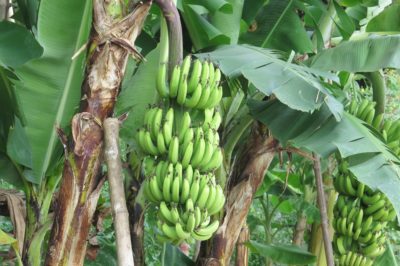Growing Conditions
Bananas generally prefer warm temperatures and high humidity. However, temperatures over 100°F (38°C) can slow or halt fruit development. Heavy feeders, these perennial herbs require rich soil and regular applications of fertilizer. Although they need lots or water and slightly moist soil, they won’t tolerate soggy soil. Some are suitable for container growing, while others are best outdoors.
Commercial Bananas
The commercial grocery store banana is usually a Cavendish variety. These kinds of bananas are grown in the tropics, harvested while still green and shipped all over the world. The primary producers of commercial bananas are:
• India
• China
• The Philippines
• Brazil
• Ecuador
• Hawaii
• Puerto Rico.
Bananas in Temperate Areas
If you live in a state like Hawaii or Florida, or in other locations such as the south of Texas or California, you should be able to grow some kinds of edible bananas without much trouble. Gardeners in USDA Zones 9 to 11 can usually grow good bananas with a little extra attention to cold protection. Some gardeners use large pots and move them indoors for winter.
Bananas Indoors
If you want to grow bananas indoors, you’ll probably have to give up the idea of fruit. Most bananas that do well indoors are strictly ornamental, don’t produce edible fruit or the fruit doesn’t ripen. These plants need bright indirect light and high humidity. They range in height from two to eight feet. Many have colorful leaves and can add a tropical feeling to your home.
Bananas in the Garden
Bananas are an understory plant, and as such, are susceptible to sunburn. Grow them in areas where trees provide dappled shade, or use shade-cloth or lath to protect them. They are heavy feeders and need very rich soil, but must also have excellent drainage. A raised bed or area specifically designed to meet their needs is usually the best choice.
Bananas vs. Plantains
Bananas and plantains are different branches on the family tree. Although they look very similar, plantains are firmer and have more starch. They are cooked before eating, while bananas are eaten raw as well as cooked. Plantains are usually hardier than true bananas, so they have a wider climate range and are less susceptible to winter temperatures – they are often grown in southern US states.
